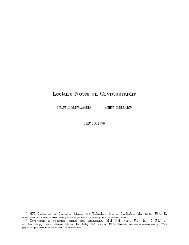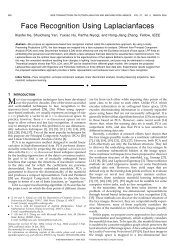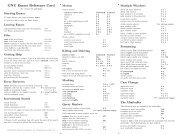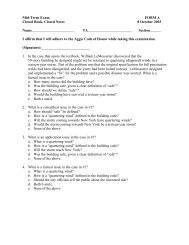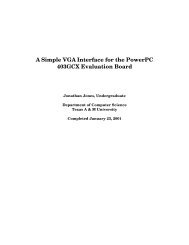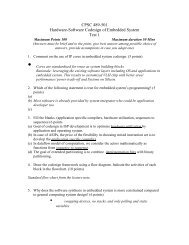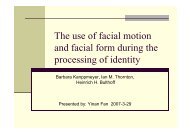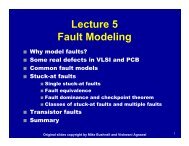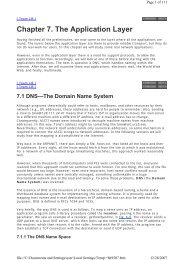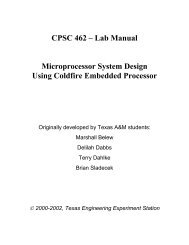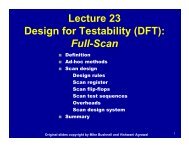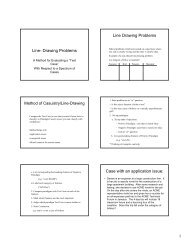Regularization Algorithms for Learning That Are Equivalent to ...
Regularization Algorithms for Learning That Are Equivalent to ...
Regularization Algorithms for Learning That Are Equivalent to ...
You also want an ePaper? Increase the reach of your titles
YUMPU automatically turns print PDFs into web optimized ePapers that Google loves.
perikarya or fibers within the graft or evidence<br />
that NPY fibers were entering the<br />
graft from the host. In contrast <strong>to</strong> implants<br />
that contained the SCN, cortical implants<br />
never res<strong>to</strong>red rhythmicity <strong>to</strong> the host. Cortical<br />
implants always contained a few NPY<br />
perikarya and many fibers. In cortical implants,<br />
NPY fibers were always seen <strong>to</strong> cross<br />
the host-graft border, and most crossing<br />
fibers seemed <strong>to</strong> originate from the host.<br />
Although most of our implants contained<br />
some portion of extra-SCN tissues (Fig. 3,<br />
A and D), the immunocy<strong>to</strong>chemical analysis<br />
showed that grafts that res<strong>to</strong>red rhythmicity<br />
always contained cells with SCN characteristics<br />
(VIP and vasopressin). There<strong>for</strong>e, the<br />
period of the overt rhythm is determined by<br />
cells within, or very close <strong>to</strong> the SCN. This<br />
observation is in agreement with reports<br />
showing that the SCN is required <strong>for</strong> successful<br />
res<strong>to</strong>ration of rhythmicity (11-14,<br />
23)<br />
İn most of our locomo<strong>to</strong>r data, rhythmicity<br />
was visually apparent within 6 <strong>to</strong> 7 days<br />
after transplantation. Although surprisingly<br />
short, this latency does not preclude the<br />
possibility that neural reconnections drive<br />
the behavior since dense neural outgrowth<br />
has been reported from other transplanted<br />
tissue with a similar time course (24). Immunocy<strong>to</strong>chemical<br />
analysis indicates that<br />
neural connections have been made between<br />
graft and host brain; however, it was not<br />
possible <strong>to</strong> determine the source of fibers<br />
crossing the graft boundary.<br />
The fact that the genotype of the host<br />
does not appear <strong>to</strong> affect significantly the<br />
expression of the transplanted rhythm is<br />
somewhat surprising, especially in view of<br />
evidence <strong>for</strong> the existence of oscilla<strong>to</strong>rs outside<br />
the SCN in the mammalian brain (15,<br />
16). We interpret the absence of a host<br />
contribution <strong>to</strong> the circadian period <strong>to</strong> mean<br />
that either the SCN is essentially au<strong>to</strong>nomous<br />
in determining the primary characteristics<br />
of rhythmicity in hamsters or that the<br />
host brain fails <strong>to</strong> make the connections with<br />
the tissue graft that are required <strong>for</strong> the<br />
brain <strong>to</strong> influence this period. In either case,<br />
our results strengthen the view that the SCN<br />
occupies a position at the <strong>to</strong>p of the circadian<br />
hierarchy in mammals.<br />
REFERENCES AND NOTES<br />
1. R. Y. Moore, in Biological Rhythms and Their Central<br />
Mechanisms, M. Suda, 0. Hayaishi, H. Hakagawa,<br />
Eds. (North-Holland, Amsterdam, 1979), pp. 343-<br />
354.<br />
2. B. Rusak and Z. Boulos, Pho<strong>to</strong>chem. Pho<strong>to</strong>biol. 34,<br />
267 (1981).<br />
3. W. J. Schwartz and H. Gainer, Science 197, 1089<br />
(1977).<br />
4. R. Y. Moore and V. B. Eichler, Brain Res. 42, 201<br />
(1972).<br />
5. F. K. Stephan and I. Zucker, Proc. Natl. Acad. Sci.<br />
U.S.A. 69, 1583 (1972).<br />
978<br />
6. B. Rusak and I. Zucker, Physiol. Rev. 59, 449<br />
(1979).<br />
7. S. T. Inouye and H. Kawamura, Proc. Natl. Acad.<br />
Sci. U.S.A. 76, 5962 (1979).<br />
8. D. J. Green and M. U. Gillette, Brain Res. 245, 198<br />
(1982).<br />
9. G. Groos and J. Hendricks, Neurosci. Lett. 34, 283<br />
(1982).<br />
10. D. J. Earnest and C. D. Sladek, Brain Res. 382, 129<br />
(1986).<br />
11. Y. Sawaki et al., Neurosci. Res. 1, 67 (1984).<br />
12. R. Drucker-Colin et al., Brain Res. 311, 353 (1984).<br />
13. M. N. Lehman et al., J. Neurosci. 7, 1626 (1987).<br />
14. P. J. DeCoursey and J. Buggy, Soc. Neurosci. Abstr.<br />
12, 210 (1986).<br />
15. K.-I. Honma, S. Honma, T. Hiroshige, Physiol.<br />
Behav. 40, 767 (1987).<br />
16. K. Abe, J. Kroning, M. A. Greer, V. Critchlow,<br />
Neuroendocrinology 29, 119 (1979); F. K. Stephan, J.<br />
M. Swann, C. L. Sisk, Behav. Neural. Biol. 25, 346<br />
(1979).<br />
17. In the avian pineal [S. A. Binkley, J. B. Riebman, K.<br />
B. Reilly, Science 202, 1198 (1978); N. H. Zimmerman<br />
and M. Menaker, Proc. Natl. Acad. Sci. U.S.A.<br />
76, 999 (1979)], in the lizard pineal [M. Menaker<br />
and S. Wisner, ibid. 80, 6119 (1983)], and in the<br />
amphibian retina [J. C. Besharse and P. M. Iuvone,<br />
Nature 305, 133 (1983)].<br />
18. M. R. Ralph and M. Menaker, Science 241, 1225<br />
(1988).<br />
19. Tissue <strong>for</strong> implantation was obtained in the following<br />
manner. Pregnant females were anesthetized and<br />
prepared <strong>for</strong> surgery on day 13.5 of gestation.<br />
Fetuses were located and decapitated in utero, and<br />
the heads were removed <strong>to</strong> a sterile petri dish<br />
containing BSS. The entire litter was collected at<br />
one time. Fetal brains were then removed under<br />
dissecting microscope and placed in a second dish.<br />
After all of the brains had been collected, each was<br />
oriented with the ventral surface visible under the<br />
microscope. All dissections were per<strong>for</strong>med with the<br />
tissue immersed in MEM-BSS. This procedure allowed<br />
the ends of the developing optic nerves <strong>to</strong><br />
float in the media so that the optic chiasm could be<br />
located easily. A coronal incision was made where<br />
the two nerves fused, and a second, parallel cut was<br />
made 1 <strong>to</strong> 1.5 mm caudal <strong>to</strong> this. Two parasagittal<br />
cuts were then made about 1.5 mm on either side of<br />
midline, with the scissors held at a 450 angle so that<br />
these cuts passed in<strong>to</strong> the third ventricle. This<br />
resulted in the excision of two small blocks of tissue<br />
connected by the optic chiasm. Neural tissue <strong>for</strong><br />
implantation was then teased away from the chiasm<br />
and pia mater.<br />
20. Tissue blocks <strong>for</strong> implantation were placed in a<br />
group at the tip of a Wiretrol micropipette. The<br />
pipette was graduated in increments of 1.0 ,ul so that<br />
the <strong>to</strong>tal volume <strong>to</strong> be injected could be estimated.<br />
The tissue occupied about 1 pl of the 1.5 <strong>to</strong> 2 p.l<br />
volume that was injected in<strong>to</strong> the host brain.<br />
21. E. Balaban, M.-A. Teillet, N. Le Douarin, Science<br />
241, 1339 (1988).<br />
22. Animals were perfused intracardially with 350 mi of<br />
4% para<strong>for</strong>maldehyde in 0.01M phosphate buffer<br />
containing 15% picric acid; the brain was removed<br />
and placed in the same fixative <strong>for</strong> an additional 24<br />
<strong>to</strong> 48 hours. Frontal sections (80 p.m) were cut on a<br />
vibra<strong>to</strong>me and processed <strong>for</strong> immunocy<strong>to</strong>chemistry<br />
as described [R. G. Foster, G. Plowman, A. Goldsmith,<br />
B. Follett, J. Endocrinol. 115, 211 (1987)]<br />
with antibodies directed against NPY (1:1000;<br />
Peninsula Labora<strong>to</strong>ries, Belmont, CA), vasopressin<br />
(1: 500; Incstar, Stillwater, MN), and VIP (1: 1000;<br />
Peninsula Labora<strong>to</strong>ries). Controls were per<strong>for</strong>med<br />
by incubating sections in absorbed primary antisera<br />
[40 nm of peptide (Peninsula Labora<strong>to</strong>ries) added<br />
<strong>to</strong> 1 ml of diluted primary antisera <strong>for</strong> 24 hours at<br />
4'C] or omitting the primary antisera. In both<br />
controls, immunostaining was abolished in the graft<br />
and host brain, except <strong>for</strong> faint staining within<br />
necrotic tissue and astrocytes around the lesion site,<br />
suggesting artifactual staining within these tissues.<br />
Necrotic tissue and astrocytes around the lesion site<br />
also showed immunostaining with VIP, NPY, and<br />
vasopressin antibodies (Fig. 3).<br />
23. R. Aguilar-Roblero, L. P. Morin, R. Y. Moore, Soc.<br />
Neurosci. Abstr. 14, 49 (1988).<br />
24. M. K. Flocter and E. G. Jones, Dev. Brain Res. 22,<br />
19 (1985).<br />
25. Supported by PHS grants MH09483 <strong>to</strong> M.R.R.,<br />
HD13162 <strong>to</strong> M.M., and HD18686 <strong>to</strong> F.C.D.<br />
28 June 1989; accepted 28 November 1989<br />
<strong>Regularization</strong> <strong>Algorithms</strong> <strong>for</strong> <strong>Learning</strong> <strong>That</strong> <strong>Are</strong><br />
<strong>Equivalent</strong> <strong>to</strong> Multilayer Networks<br />
T. POGGIO AND F. GIRosI<br />
<strong>Learning</strong> an input-output mapping from a set of examples, of the type that many<br />
neural networks have been constructed <strong>to</strong> per<strong>for</strong>m, can be regarded as synthesizing an<br />
approximation of a multidimensional function (that is, solving the problem of<br />
hypersurface reconstruction). From this point of view, this <strong>for</strong>m of learning is closely<br />
related <strong>to</strong> classical approximation techniques, such as generalized splines and regularization<br />
theory. A theory is reported that shows the equivalence between regularization<br />
and a class of three-layer networks called regularization networks or hyper basis<br />
functions. These networks are not only equivalent <strong>to</strong> generalid splines but are also<br />
closely related <strong>to</strong> the classical radial basis functions used <strong>for</strong> interpolation tasks and <strong>to</strong><br />
several pattern recognition and neural network algorithms. They also have an<br />
interesting interpretation in terms of pro<strong>to</strong>types that are synthesized and optimally<br />
combined during the learning stage.<br />
M j ' OST NEURAL NETWORKS AT- puts from a set of correct input-output pairs,<br />
tempt <strong>to</strong> synthesize modules that called examples. Some of the best known<br />
transduce inputs in<strong>to</strong> desired out- applications are a network that maps English<br />
spelling in<strong>to</strong> its phonetic pronunciation<br />
(1) and a network that leams the map-<br />
Artificial Intelligence Labora<strong>to</strong>ry, Center <strong>for</strong> Biological<br />
In<strong>for</strong>mation Processing, Massachusetts Institute of ch- ping corresponding <strong>to</strong> a chaotic dynamical<br />
nology, Cambridge, MLA 02139.<br />
system, thereby predicting the future from<br />
SCIENCE, VOL. 247<br />
Downloaded from www.sciencemag.org on February 23, 2010
the past (2). In these cases, learning takes<br />
place when the weights of connections in a<br />
multilayer network of simple units are<br />
changed, according <strong>to</strong> a gradient descent<br />
scheme called backpropagation (3). It would<br />
be highly desirable <strong>to</strong> establish theoretical<br />
foundations <strong>for</strong> using multilayer networks<br />
of this general type <strong>to</strong> learn from examples.<br />
To show how this goal can be achieved, we<br />
first explain how <strong>to</strong> rephrase the problem of<br />
learning from examples as a problem of<br />
approximatmg a multvariate function.<br />
To illustrate the connection, let us draw<br />
an analogy between learning an input-output<br />
mapping and a standard approximation<br />
problem, two-dimensional (2-D) surface reconstruction<br />
from sparse data points. <strong>Learning</strong><br />
simply means collecting the examples,<br />
that is, the input coordinates xi, yi and the<br />
corresponding output values at those locations,<br />
the heights of the surface di. Generalization<br />
means estimating d at locations x, y<br />
where there are no examples, that is, no<br />
data. This requires interpolating or, more<br />
generally, approximating the surface (the<br />
function) between the data points (interpolation<br />
is the limit of approximation when<br />
there is no noise in the data). In this sense,<br />
learning is a problem of hypersurface reconstruction<br />
(4, 5).<br />
From this point of view, learning a<br />
smooth mapping from examples is clearly an<br />
ill-posed problem (6), in the sense that the<br />
in<strong>for</strong>mation in the data is not sufficient <strong>to</strong><br />
reconstruct uniquely the mapping in regions<br />
where data are not available. In addition, the<br />
data are usually noisy. A priori assumptions<br />
about the mapping are needed <strong>to</strong> make the<br />
problem well-posed. One of the simplest<br />
assumptions is that the mapping is smooth:<br />
small changes in the inputs cause a small<br />
change in the output (7).<br />
Techniques that exploit smoothness constraints<br />
in order <strong>to</strong> trans<strong>for</strong>m an ill-posed<br />
problem in<strong>to</strong> a well-posed one are well<br />
known under the term of regularization<br />
theory (6, 8). Consider the inverse problem<br />
of finding the hypersurface _ix), given its<br />
value di on a finite set of points {I,} of its<br />
domain. This problem is clearly ill-posed<br />
because it has an infinite number of solutions,<br />
and some constraint must be imposed<br />
on the solution. A standard technique in<br />
regularization theory solves the problem by<br />
minimizing a cost functional consisting of<br />
two terms. The first term measures the<br />
distance between the data and the desired<br />
solution f, the second term measures the<br />
cost associated with the deviation from<br />
smoothness. Its <strong>for</strong>m is IIPilI2, where P is<br />
usually a differential opera<strong>to</strong>r, called a stabi-<br />
-<br />
lizer, and 11 11 is a norm on the function<br />
space <strong>to</strong> which Pf belongs (usually the L2<br />
norm). The term is small <strong>for</strong> smooth f<br />
23 FEBRUARY 1990<br />
whose derivatives have small norms. Thus,<br />
the method selects the hypersurface f that<br />
solves the variational problem of minimizing<br />
the functional<br />
N<br />
H[f] =I (d, -f(g,))2 + X11Pj12 (1)<br />
where d, are the values ofthe hypersurface at<br />
the given N points 4 i, and X, the regularization<br />
parameter, controls the compromise<br />
between the degree of smoothness of the<br />
solution and its closeness <strong>to</strong> the data (9). For<br />
instance, in one dimension with<br />
Ip2 Jd[d2x(x) ]2 (2)<br />
the function f(x) that minimimzes the functional<br />
of Eq. 1 is a "cubic spline," a curve<br />
that is a cubic polynomial between the<br />
knots, with continuous second-order derivative<br />
at the knots (10).<br />
The <strong>for</strong>mulation of the learning problem<br />
x1 2 xn 1<br />
f<br />
Fig. 1. The HyperBf network used <strong>to</strong> approximate<br />
a mapping between xl, x2, ..., xn and f<br />
given a set of sparse, noisy data. The data, a set of<br />
points <strong>for</strong> which the value of the function is<br />
known, can be considered as examples <strong>to</strong> be used<br />
during learning. The hidden units evaluate the<br />
function G(x;t"), and a fixed, nonlinear, invertible<br />
function may be present after the sunmnation.<br />
The units are, in general, fewer than the number<br />
of examples. The parameters that may be determined<br />
during learning are the coefficients c,", the<br />
centers t,, and the matrix W. In the radial case, G<br />
= G(lx - t"II2w) and the hidden units simply<br />
compute the radial basis functions G at the "centers"<br />
t,,. The RBFs may be regarded as matching<br />
the input vec<strong>to</strong>rs against the "templates" or "pro<strong>to</strong>types"<br />
that correspond <strong>to</strong> the centers (consider,<br />
<strong>for</strong> instance, a radial Gaussian around its center,<br />
which is a point in the n-dimensional space of<br />
inputs). Updating a center tat during learning is<br />
equivalent <strong>to</strong> modifying the corresponding pro<strong>to</strong>type.<br />
Changing the weights W corresponds <strong>to</strong><br />
per<strong>for</strong>ming dimensionality reduction on the input<br />
features. In addition <strong>to</strong> the linear combination of<br />
basis functions, the figure includes other terms<br />
that contribute <strong>to</strong> the output: constant and linear<br />
terms are shown here as direct connections from<br />
the input <strong>to</strong> the output with weights ao, a,, a2,**-<br />
a, (37).<br />
in terms of regularization is satisfying from a<br />
theoretical point of view, because it establishes<br />
connections with a large body of<br />
results in the area ofBayesian estimation and<br />
in the theory of approximation of multivariate<br />
functions (11). In particular, Eq. 1 can<br />
be used <strong>to</strong> define generalized spines in any<br />
dimension. At this point, it is natural <strong>to</strong> ask<br />
about the connection between this perspective<br />
on learning as an approximation problem<br />
and feed<strong>for</strong>ward networks, such as<br />
backpropagation, that have become popular<br />
recently, exactly because of their capabilities<br />
<strong>to</strong> "learn from examples."<br />
In the following, we provide an answer <strong>to</strong><br />
the previous question by showing that the<br />
solution <strong>to</strong> the approximation problem given<br />
by regularization theory can be expressed<br />
in terms of a class of multilayer networks<br />
that we call regularization networks or<br />
hyper basis functions (HyperBFs) (see Fig.<br />
1) and that are similar <strong>to</strong> previously suggested<br />
networks (12, 13). Our main result is that<br />
the regularization approach is equivalent <strong>to</strong><br />
an expansion of the solution in terms of a<br />
certain class of functions that depends only<br />
on the <strong>for</strong>m of the stabilizing opera<strong>to</strong>r. We<br />
explain how this expansion can be interpreted<br />
in terms of a network with one layer of<br />
hidden units whose characteristics are dictated<br />
by the theory. We also discuss a computationally<br />
efficient scheme <strong>for</strong> synthesizing the<br />
associated network from a set of examples,<br />
which has an interesting interpretation and<br />
several promising extensions.<br />
We outline first how an approximation in<br />
terms of a specific dass of functions, often<br />
radial, can be derived directly from regularization.<br />
The regularization approach selects<br />
the function f that solves the variational<br />
problem ofminimizing the functional ofEq.<br />
1. It can be proved (5) that the solution has<br />
the following simple <strong>for</strong>m:<br />
N<br />
f(x) = I ci G(x;gi)<br />
i=l<br />
(3)<br />
where G(x) is the Green's function of the<br />
self-adjoint differential opera<strong>to</strong>r PP, P being<br />
the adjoint opera<strong>to</strong>r of P, and the coefficients<br />
ci satisfy a linear system of equations<br />
that depend on the N "examples," that is,<br />
the data <strong>to</strong> be approximated (14). If P is an<br />
opera<strong>to</strong>r with radial symmetry, the Green's<br />
function G is radial and there<strong>for</strong>e the approximating<br />
function becomes:<br />
N<br />
f(x) = E: ci G(I* gj12)<br />
i=l<br />
(4)<br />
which is a sum of radial functions, each with<br />
its center ti on a distinct data point. Thus<br />
the number of radial functions, and corresponding<br />
centers, is the same as the number<br />
of examples.<br />
Our derivation shows that the type of<br />
REPORTS 979<br />
Downloaded from www.sciencemag.org on February 23, 2010
asis functions depends on the stabilizer P,<br />
that is, on the specific a priori assumption<br />
(5). Depending on P we obtain the Gaussian<br />
G(r) = e-(r/C)2, the well-known "thin-plate<br />
spline" G(r) = r2 In r, and other specific<br />
functions, radial or not (15). As observed by<br />
Broomhead and Lowe (12) in the radial<br />
case, a superposition of functions such as<br />
that in Eq. 3 is equivalent <strong>to</strong> a network of<br />
the type shown in Fig. 1. The interpretation<br />
of Eq. 4 is simple: in the 2-D case, <strong>for</strong><br />
instance, the surface is approximated by the<br />
superposition of, say, several 2-D Gaussian<br />
distributions, each centered on one of the<br />
data points.<br />
Equation 4 has the same <strong>for</strong>m as an<br />
interpolation technique, called radial basis<br />
functions (RBFs), that has been extensively<br />
studied (16). In 1986 Micchelli proved a<br />
powerful result that justifies the use of a<br />
large class of functions as interpolating<br />
RBFs (17, 18). It turns out (5) that the class<br />
of radial functions satisfying Micchelli's condition<br />
is closely related <strong>to</strong> the larger class of<br />
functions defined by Eq. 1.<br />
The network associated with Eq. 4 has a<br />
complexity (number of radial functions) that<br />
is independent of the dimensionality of the<br />
input space but is on the order of the<br />
dimensionality of the training set (number<br />
of examples), which is usually high. Broomhead<br />
and Lowe (12) used fewer centers than<br />
data points. A heuristic scheme with movable<br />
centers and Gaussian functions has also<br />
been proposed and tested (13). It turns out<br />
that our previous rigorous result can be<br />
extended in a natural way <strong>to</strong> a scheme in<br />
which the number of centers is much smaller<br />
than the number of examples. In the framework<br />
of regularization the consistent extension<br />
we derive has the feature of center<br />
positions that are modified during learning<br />
(5). The extension is<br />
n<br />
ff(x) = E c, G(x;t,) (5)<br />
a=l<br />
where the parameters t.,, which we call<br />
"centers" in the radial case, and the coefficients<br />
c. are unknown and are in general<br />
fewer than the data points (n c N) (19).<br />
Equation 5, which can be implemented by<br />
the network of Fig. 1, is equivalent <strong>to</strong><br />
generalized splines with free knots, whereas<br />
Eq. 4 is equivalent <strong>to</strong> generalized splines<br />
with fixed knots. This scheme can be further<br />
extended by considering in Eq. 5 the superposition<br />
of different types of functions G,<br />
such as Gaussians at different scales (20). In<br />
addition, the norm 1lx - 4,j1 may be considered<br />
as a weighted norm<br />
|x - g 4lI = (x - 4i)"TWTW(x - i) (6)<br />
where W is a matrix and the superscript T<br />
indicates the transpose. In the simple case of<br />
980<br />
diagonal W, the diagonal elements wi assign<br />
a specific weight <strong>to</strong> each input coordinate.<br />
They play a critical role whenever different<br />
types of inputs are present. Iterative methods<br />
of the gradient descent type can be used<br />
<strong>to</strong> find the optimal values of the various sets<br />
of parameters, the ca, the wij, and the ta,<br />
that minimize an error functional on the set<br />
of examples. Since this functional is no<br />
longer convex, a s<strong>to</strong>chastic term in the gradient<br />
descent equations may be used <strong>to</strong><br />
avoid local minima (21).<br />
The network of Fig. 1 may be interpreted<br />
as follows. The centers of the radial functions<br />
are similar <strong>to</strong> pro<strong>to</strong>types, since they are<br />
points in the multidimensional input space.<br />
Each unit computes a (weighted) distance of<br />
the inputs from its center, which is a measure<br />
of their similarity, and applies <strong>to</strong> it the<br />
radial function. In the case of the Gaussian, a<br />
unit will have maximum activity when the<br />
new input exactly matches its center. The<br />
output of the network is the linear superposition<br />
of the activities of all the radial functions<br />
in the network. One finds the corresponding<br />
weights during learning by minimizing<br />
a measure of the error between the<br />
network's prediction and each of the examples.<br />
At the same time, the centers of the<br />
radial functions and the weights in the norm<br />
are also updated during learning. Moving<br />
the centers is equivalent <strong>to</strong> modifying the<br />
corresponding pro<strong>to</strong>types and corresponds<br />
<strong>to</strong> task-dependent clustering. Finding the<br />
optimal weights <strong>for</strong> the norm is equivalent<br />
Fig. 2. (A) The HyperBF<br />
network proposed <strong>for</strong> the<br />
recognition of a 3-D object A 1 Y1 x2 B<br />
from any of its perspective<br />
<strong>to</strong> trans<strong>for</strong>ming appropriately, <strong>for</strong> instance,<br />
scaling, the input coordinates and corresponds<br />
<strong>to</strong> task-dependent dimensionality reduction.<br />
Figure 2 shows a specific application of<br />
HyperBFs. Consider the problem of recognizing<br />
a wire-frame 3-D object from any of<br />
its perspective views. A view of the object is<br />
represented as a 2N vec<strong>to</strong>r xl, yi, x2, Y2 *..*<br />
XN, YN of the coordinates on the image<br />
plane ofN labeled and visible points on the<br />
object. Additional different typs of features<br />
can also be used, such as angles between<br />
vertices. The network leams <strong>to</strong> map any<br />
view of the object in<strong>to</strong> a standard view. The<br />
results with images generated with computer<br />
graphics <strong>to</strong>ols (of the type indicated in<br />
Fig. 2B) are encouraging and have promising<br />
extensions <strong>to</strong> more realistic data (22).<br />
Many existing schemes <strong>for</strong> networks that<br />
learn are encompassed by the HyperBF<br />
framework (5). Past work, in the special case<br />
of fixed centers, indicates good per<strong>for</strong>mance<br />
in a number of tasks (23). Our own preliminary<br />
work, as well as earlier experiments of<br />
Moody and Darken with a similar network<br />
(13), suggests that the more general <strong>for</strong>m of<br />
HyperBFs has a promising per<strong>for</strong>mance.<br />
The scheme is a satisfying theory of networks<br />
<strong>for</strong> learning. HyperBFs are the feed<strong>for</strong>ward<br />
network versions of regularization<br />
and are there<strong>for</strong>e equivalent <strong>to</strong> generalized<br />
splines. The HyperBF network is similar <strong>to</strong><br />
the architecture used <strong>for</strong> backpropagation,<br />
being a multilayer network with one hidden<br />
views. The network at- I l I-<br />
tempts <strong>to</strong> map any view (as<br />
defined in the text) in<strong>to</strong> a<br />
standard view, arbitrarily<br />
chosen. The norm of the<br />
difference between the output<br />
vec<strong>to</strong>r f and the stan- i)) if **. ii i)*.fl<br />
dard view s is thresholded <strong>to</strong><br />
yield a 0, 1 answer. The 2N<br />
inputs accommodate the in- + + + ... +<br />
put vec<strong>to</strong>r v representing an<br />
arbitrary view. Each of the<br />
K RBFs is initially centered I f-s lIf ḻI<br />
on one of a subset of the M<br />
views used <strong>to</strong> synthesize the<br />
system (K c M). During j-<br />
training each of the M inputs<br />
in the training set is<br />
associated with the desired o,1 o,1<br />
output, the standard view s.<br />
(B) A completely equivalent interpretation of (A) <strong>for</strong> the special case of Gaussian RBFs. Gaussian<br />
functions can be synthesized by multiplying the outputs of 2-D Gaussian receptive fields that "look" at<br />
the retino<strong>to</strong>pic map of the object point features. The solid circles in the image plane represent the 2-D<br />
Gaussians associated with the first RBF, which represents the first view of the object. The dotted circles<br />
represent the 2-D receptive fields that synthesize the Gaussian RBF associated with another view. The<br />
2-D Gaussian receptive fields transduce positions of features, represented implicitly as activity in a<br />
retino<strong>to</strong>pic array, and their product "computes" the radial function without the need <strong>to</strong> calculate norms<br />
and exponentials explicitly. See (5) <strong>for</strong> more details.<br />
SCIENCE, VOL. 247<br />
Downloaded from www.sciencemag.org on February 23, 2010
layer and two or even three sets of adjustable<br />
parameters. Its Boolean limiting version<br />
carves the input space in<strong>to</strong> hyperspheres,<br />
each corresponding <strong>to</strong> a center: a radial unit<br />
is active if the input vec<strong>to</strong>r is within a certain<br />
radius of its center and is otherwise silent.<br />
The Boolean limit of backpropagation<br />
carves the space with hyperplanes. With an<br />
arbitrary number of units each network can<br />
approximate the other, since each network<br />
can approximate arbitrarily well continuous<br />
functions on a limited interval (24, 25).<br />
Multilayer networks with sigmoid units do<br />
not have, however, the best approximation<br />
property that regularization networks have<br />
(25). The Boolean limit of HyperBF is<br />
almost identical <strong>to</strong> Kanerva's associative<br />
memory algorithm (26), which is itself closely<br />
related <strong>to</strong> vec<strong>to</strong>r quantization. Parzen<br />
windows, potential techniques in pattern<br />
recognition, and kernel estimation methods,<br />
in general (27), can be regarded as special<br />
cases of the HyperBF method. Close analogies<br />
between Kanerva's model and Marr's<br />
(28) and Albus's (29) models of the cerebellum<br />
also exist (5, 30). The update equation<br />
that controls the evolution of the centers ta,<br />
[see Eq. 14 in (21)] is also similar <strong>to</strong> Kohonen's<br />
<strong>to</strong>pology-preserving algorithm (5, 31)<br />
[which is also similar <strong>to</strong> the k-means algorithm<br />
(32)] and can be interpreted as a<br />
learning scheme in which the centers of the<br />
radial functions move <strong>to</strong> find centers of<br />
clusters of input vec<strong>to</strong>rs (33). Coarse coding<br />
techniques and product units (34) can be<br />
interpreted neatly within the HyperBF<br />
framework (<strong>for</strong> the special case of Gaussian<br />
RBFs) (5, 35).<br />
Thus HyperBFs represent a general<br />
framework <strong>for</strong> learning smooth mappings<br />
that rigorously connects approximation theory<br />
and regularization with feed<strong>for</strong>ward<br />
multilayer networks. In particular, it suggests<br />
that the per<strong>for</strong>mance of networks of<br />
this general type can be unders<strong>to</strong>od in the<br />
framework of classical approximation theory,<br />
providing limits on what feed<strong>for</strong>ward<br />
networks may be expected <strong>to</strong> per<strong>for</strong>m (5).<br />
In the Gaussian case, it also suggests a<br />
scheme <strong>for</strong> learning a large class of mappings<br />
that has intriguing features from the<br />
point of view of a brain scientist, since the<br />
overall computation is a simple but powerful<br />
extension of a look-up table, that is, a memory,<br />
and can be per<strong>for</strong>med by the superposition<br />
of "units," in the appropriate multidimensional<br />
input space. These units would<br />
be somewhat similar <strong>to</strong> "grandmother" filters<br />
with a graded response, rather than<br />
binary detec<strong>to</strong>rs, each representing a pro<strong>to</strong>type.<br />
They would be synthesized as the<br />
conjunction of, <strong>for</strong> instance, 2-D Gaussian<br />
receptive fields looking at a retino<strong>to</strong>pic map<br />
of features (see Fig. 2B). During learning,<br />
the weights of the various pro<strong>to</strong>types in the<br />
network output are modified <strong>to</strong> find the<br />
optimal values that minimize the overall<br />
error. The pro<strong>to</strong>types themselves are slowly<br />
changed <strong>to</strong> find optimal pro<strong>to</strong>types <strong>for</strong> the<br />
task. The weights of the different input<br />
features are also modified <strong>to</strong> per<strong>for</strong>m taskdependent<br />
dimensionality reduction.<br />
A scheme of this type is broadly consistent<br />
with recent physiological evidence [see, <strong>for</strong><br />
instance, (36)] on face recognition neurons<br />
in the monkey inferotemporal cortex. Some<br />
of the neurons described have several of the<br />
properties expected from the units of Fig. 2<br />
with a center, that is, a pro<strong>to</strong>type that<br />
corresponds <strong>to</strong> a view of a specific face. A<br />
similar scheme could be used <strong>to</strong> learn other<br />
visual tasks, such as the computation of<br />
color constancy or shape from shading from<br />
a set of examples, although the biological<br />
relevance in such cases is more questionable.<br />
In any case, it remains <strong>to</strong> be seen whether<br />
some cortical neurons indeed have the multidimensional,<br />
possibly Gaussian-like, receptive<br />
fields suggested by this approach.<br />
REFERUENCES AND NOTES<br />
1. T. J. Sejnowski and C. R. Rosenberg, Complex Syst.<br />
1,145 (1987).<br />
2. A. Lapedes and R. Farber, Tech. Rep. LA-UR-87-<br />
2662 (Los Alamos National Labora<strong>to</strong>ry, Los Alamos,<br />
NM, 1982).<br />
3. D. E. Rumelhart, G. E. Hin<strong>to</strong>n, R. J. Williams,<br />
Nature 323, 533 (1986).<br />
4. T. Poggio et al., in Proceedings Image Understanding<br />
Workshop, L. Bauman, Ed. (Cambridge, MA, April<br />
1988) (Morgan Kaufmann, San Mateo, CA, 1988),<br />
pp. 1-12. See also S. Omohundro, Complex Syst. 1,<br />
273 (1987).<br />
5. T. Poggio and F. Girosi, Artif Intell. Memo 1140<br />
(Artificial Intelligence Labora<strong>to</strong>ry, Massachusetts<br />
Institute of Technology, Cambridge, 1989).<br />
6. A. N. Tikhonov and V. Y. Arsenin, Solutions of Ill-<br />
Posed Problems (Wins<strong>to</strong>n, Washing<strong>to</strong>n, DC, 1977).<br />
7. Other stronger a priori constraints may be known,<br />
<strong>for</strong> instance, that the mapping is linear, or has a<br />
positive range or a limited domain, or is invariant<br />
under some group of trans<strong>for</strong>mations.<br />
8. T. Poggio, V. Torre, C. Koch, Nature 317, 314<br />
(1985); M. Bertero, T. Poggio, V. Torre, Proc.<br />
IEEE 76, 869 (1988); J. L. Marroquin, S. Mitter,<br />
T. Poggio, J. Am. Stat. Assoc. 82, 76 (1987); G.<br />
Wahba, Spines Models<strong>for</strong> Observational Data (Series in<br />
Applied Mathematics, Society <strong>for</strong> Industrial and<br />
Applied Mathematics, Philadelphia, 1990), vol. 59,<br />
and references therein.<br />
9. The parameter X is directly related <strong>to</strong> the degree of<br />
generalization that is en<strong>for</strong>ced and <strong>to</strong> an estimate of<br />
the noise (8).<br />
10. L. L. Schumaker, Spline Functions: Basic Theory (Wiley,<br />
New York, 1981).<br />
11. Equation 1 can be grounded on Bayesian estimation<br />
[see, <strong>for</strong> instance, G. Kimeldorf and G. Wahba,<br />
Ann. Math. Stat. 41,495 (1970)] and connected <strong>to</strong><br />
estimation and coding principles such as the minimum<br />
length principle of J. Rissanen [Au<strong>to</strong>matica 14,<br />
465 (1978)]. See also (5). The first term of Eq. 1 is<br />
associated with the conditional probability that corresponds<br />
<strong>to</strong> a model of Gaussian additive noise,<br />
whereas the second term is associated with the prior<br />
probability of the solution. Minimizing the functional<br />
corresponds <strong>to</strong> the maximum a posteriori<br />
(MAP) estimate, that is, maximizing the posterior<br />
probability offgiven the dataf(ti) (8). In addition,<br />
the solutions provided by standard regularization<br />
are known <strong>to</strong> be equivalent <strong>to</strong> generalized splines.<br />
This allows the use of a large body of results on<br />
fitting and approximating with splines. Furthermore,<br />
we have shown that standard regularization<br />
can be implemented by using analog networks of<br />
resis<strong>to</strong>rs and batteries (8). Thus, spline-based learning<br />
can be implemented in terms of the same analog,<br />
iterative networks used <strong>for</strong> 2-D surface reconstruction,<br />
but with higher connectivity.<br />
12. D. S. Broomhead and D. Lowe, Complex Syst. 2,<br />
321 (1988).<br />
13. J. Moody and C. Darken, Neural Comput. 1, 281<br />
(1989).<br />
14. Depending on the stabilizer, a term belonging <strong>to</strong> the<br />
null space of P, usually a polynomial, may have <strong>to</strong> be<br />
added <strong>to</strong> the right side of Eq. 3. Disregarding this<br />
term <strong>for</strong> simulicity, the coefficients are given by c =<br />
(G + XI)- d, where (d)i = di and (G)V =<br />
G(4j;4j) (I is the identity opera<strong>to</strong>r). In the limit X =<br />
0, corresponding <strong>to</strong> noiseless data, we obtain a<br />
method of interpolating a multivariate function.<br />
15. Thin-plate splines in two dimensions correspond <strong>to</strong><br />
the functional<br />
llP112 = 1R2 dxdy{[ axj<br />
+ 2f(x Y) 12<br />
l axay J<br />
2<br />
+<br />
cy2J<br />
that is, the bending energy of a thin plate of infinite<br />
extent. The d-dimensional Gaussian G of variance cr<br />
is generated by<br />
IIPilI2 = m!2m fR dX[D"f(x)]2 (8)<br />
where D2- = V2-,2"'2 VV2', V2 is the Laplacian<br />
opera<strong>to</strong>r, and Vis the gradient opera<strong>to</strong>r. Tensor<br />
product splines correspond <strong>to</strong> stabilizing opera<strong>to</strong>rs<br />
that are the product of "one-dimensional" opera<strong>to</strong>rs<br />
and are not radial. In two dimensions, <strong>for</strong> example,<br />
they correspond <strong>to</strong> stabilizers of the <strong>for</strong>m P = P.Py,<br />
where Px(Py) is a differential opera<strong>to</strong>r involving only<br />
derivatives with respect <strong>to</strong> x(y). The Green's functions<br />
associated with PvPy is the product of the<br />
Green's functions associated with P, and Py. The 2-<br />
D problem is then regarded as the "tensor product"<br />
of two 1-D problems.<br />
16. M. J. D. Powell, in <strong>Algorithms</strong> <strong>for</strong> Approximation, J.<br />
C. Mason and M. G. Cox, Eds. (Clarendon, Ox<strong>for</strong>d,<br />
1987), pp. 143-167; R. Franke, Math. Comput. 38,<br />
181 (1982).<br />
17. C. A. Miccheili, Constr. Approx. 2, 11 (1986).<br />
18. For nonzero X our method can be considered as an<br />
extension of the original RBF method <strong>to</strong> approximate<br />
noisy data: regularization justifies the use of<br />
RBF expansions as an approximation method.<br />
19. The extension amounts <strong>to</strong> searching a solution in a<br />
lower dimensional space. A standard technique is <strong>to</strong><br />
expand the solutionf(x) on a finite basis, that is,<br />
f(x) = I c,4),(x)<br />
a1=1<br />
(9)<br />
where {,)j ,=I is a set of linearly independent functions<br />
[see, <strong>for</strong> instance, G. Wahba, in Approximation<br />
Theory III, E. W. Cheney, Ed. (Academic Press,<br />
New York, 1980), p. 905]. The coefficients c, are<br />
then found according <strong>to</strong> a rule that guarantees a<br />
minimum deviation from the true solution. In our<br />
case we set n < N and i,. = G(jl - t.II2), where the<br />
set of "centers" {t,,,j= is <strong>to</strong> be determined. This is<br />
the only choice that guarantees that in the case of<br />
n = N and {t}n= I = {It}1NX the correct solution (of<br />
Eq. 1) is consistently recovered. The chosen expansion<br />
has the additional desirable property of being a<br />
universal approxima<strong>to</strong>r (25).<br />
20. In the HyperBF scheme the basis functions may be<br />
nonradial, at different resolutions, and of different<br />
types<br />
p<br />
n<br />
f(x) = I X c'nGm(x;t)<br />
m=l n=1<br />
(7)<br />
(10)<br />
where the set of parameters 4i' and an are unknown.<br />
This corresponds <strong>to</strong> the prior assumptions off being<br />
the superposition of several components J', each<br />
23 FEBRUARY I990 REPORTS 98I<br />
Downloaded from www.sciencemag.org on February 23, 2010
with its own stabilizer P". In an example of a priori<br />
in<strong>for</strong>mation, the function <strong>to</strong> be approximated has<br />
components on a number p of scales cr1, . c..a,.<br />
Then<br />
lIPJtri2= £ a4k dx[Dkf(x)]2 (11)<br />
where D2k = V2k, D2*+' = VV2k, and ak<br />
au!/k!2k. As a result, the solution will be a superposition<br />
of superpositions of Gaussians of different<br />
variance. In the radial case the norm is in general a<br />
weighted norm that scales differently the different<br />
types of input dimensions. Basis functions associated<br />
with different stabilizers may have differently<br />
weighted norms.<br />
21. We consider the radial case <strong>for</strong> simplicity. For fixed<br />
E,, the c,, can be found as c = (GTG + Xg)-lGTd,<br />
where GCa = G(4i - tall2), g8Q3 = G(IIt - tIl2),<br />
and GT is the transpose of G. We consider the case<br />
of movable centers ta and a weighted norm with<br />
matrix W. If the least-square error is minimized, the<br />
updating rules <strong>for</strong> the coefficients c,,, the norm<br />
matrix W, and the centers ta are (in the case of<br />
- 0):<br />
N<br />
ck+1) =<br />
<strong>to</strong>k) + 2w £ A,G(i, - t12i) + 4<br />
a=1,<br />
. ntt (12)<br />
n N<br />
W(k+1) = W(k) - 4W(k)(a I X Aj G'<br />
Q=1 i=1<br />
x (lgitallw) QiT+ (13)<br />
N<br />
{^,,k+1) = t- 4w0c, £ AiG ,<br />
( -1i-IW)<br />
X WTW(6i- ta) +4,oV a 1,... n (14)<br />
where w is a parameter related <strong>to</strong> the rate of<br />
convergence <strong>to</strong> the fixed point; d is the dimensionality<br />
of the input space; pQ, {, and yj are Gaussian<br />
noise terms; (ti - t)j is the jth component of the<br />
vec<strong>to</strong>r ( i -t.)<br />
K<br />
A,i= yj - caG(l4i - ta11') (15)<br />
a=1<br />
is the error between the desired output and the<br />
network's output <strong>for</strong> example i, and Qi





